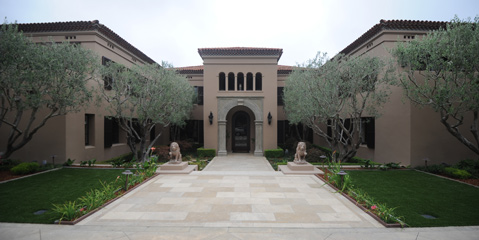Montecito Entitled to More Water?
Some Residents Think So, but Are Fined Heavily for Overuse During Drought

Montecito, the wealthiest and least water-secure community on the South Coast, is breaking its addiction to overwatering, even as some residents remain hooked.
Strict rationing went into effect in Montecito in March to avert a looming shortage during the drought. Since then, the Montecito Water District has assessed $1.1 million in penalties against more than 800 customers for exceeding their water allocations, officials say — tough love for a community that prizes its leafy hedgerows, velvety lawns, and lushly landscaped estates.
Dozens of customers are appealing their penalties, but the culture is changing, said Tom Mosby, the district’s general manager. Compared to the same months last year, he said, water use dropped 47 percent in March, 43 percent in April, and 38 percent in May. Lawns and golf courses are turning brown.
“I’ve never seen anything like it,” Mosby said. “I’m in a state of shock. People are paying attention to their water bills. They’re getting on their hands and knees and reading their meters.”

By contrast, with no penalties in the offing, Santa Barbara residents cut their water use by only 12 percent in March and 5 percent in April, officials said. But the city’s residential water use in 2013, during Year 2 of the ongoing drought, was 87 gallons per capita per day, compared to 320 gallons in Montecito, records show.
“This is difficult,” said Darlene Bierig, president of the Montecito Water District’s board. “There are people who have extraordinary amounts of money invested in their landscape who are having to do triage. No one likes it. But water is precious, and we have to adapt.”
At the same time, Mosby said, “There is a small minority that still believes they deserve grass.” Six hundred district customers were assessed penalties in April for exceeding their water allocations, he said, and 811 were assessed in May, many for the second time. The district provides water to 4,360 customers, most of them homes, serving a population of 13,500 people in Montecito and Summerland. (The district denied a public records request filed by this reporter for the names and addresses of the top water users and the customers who have been penalized).
To bypass rationing, some residents have resorted to trucking in water from elsewhere, installing temporary tanks on their property, and paying about 14 times the cost of district water for the service. A few are proposing to build new swimming pools and fill them with trucked-in water.
Meanwhile, several dozen residents have applied to the county for permission to dig private wells, even as others abandon wells that have gone dry. And in the foothills, a hotel took water from a creek and was ordered to put the water back.
Bierig is hoping Montecitans will look beyond the immediate crisis and come to terms with the semi-arid Mediterranean climate of the region. “We have to live within our means,” she said. “We have to make a permanent change in our water philosophy. This drought has been a game-changer — the severity of it and the lack of backup supplies. I’m talking about drinking water security for Montecito. We cannot go back to our old ways.”
Unlike other South Coast districts, Montecito does not have a significant supply of groundwater to help buffer a prolonged drought. Its reservoir supplies are shrinking fast. And like other districts, Montecito can count on only 5 percent of its water supply from the state aqueduct this year.
Thanks to rationing, Mosby said, the district will be able to provide enough “inside” water next year for its customers to drink, bathe, and wash clothes, even if it doesn’t rain. But if the drought continues, he said, the district will need to purchase supplemental water, even with rationing, to continue providing water for landscaping.
Seven of the top 10 residential water guzzlers of 2013 have slashed their district water use by 70 percent or more this year, Mosby said. And in May, he said, district use overall was 25 percent under allocations. The allocations are based on average use in dry years per customer category — single-family residential, multifamily, institutional, or agricultural. Size is factored in, too, since 40 percent of customers own one or more acres of land. Penalties for exceeding allocations go up sharply after the first month. The district reserves the right to shut off the water of repeat offenders.
In a rush to circumvent rationing, Montecitans have submitted 51 well applications during this fiscal year, more than in the last 13 years combined, according to county Environmental Health Services. On average, the county said, it costs between $40,000 and $50,000 to drill a single well.

Other Montecitans have contracted with such companies as A-1 Water in Goleta, Aqua Truck Inc. in Santa Barbara, and Jimenez Nursery Inc. to import private water supplies. On one development application under review at the district, A-1 Water estimates it would cost $1,700 to deliver 20,000 gallons of water for a new pool.
The district has stopped providing water for new swimming pools or for topping off existing pools, Mosby said, but it does not have jurisdiction over non-district water.
“We don’t like it,” he said. “It’s still water from a groundwater basin on the South Coast. From a social consciousness standpoint, the entire community is suffering from a water emergency and people are trucking in water to fill their pools? Does that speak for itself?”
The trucking doesn’t sit well with neighboring water districts, either. Beginning October 1, all South Coast water districts, including Montecito’s, are facing a 55 percent cut in their allocations from Lake Cachuma, the main water supply for the South Coast.
“We would be really upset if anyone were using our groundwater for purposes outside the district,” said Charles Hamilton, general manager of the Carpinteria Valley Water District. “We don’t want people marketing water from our basin, certainly not in times of drought.”
Last month, a Carpinteria district engineer spotted a water tanker filling up at a City of Carpinteria flood control channel that feeds into Franklin Creek, Hamilton said. And someone called the state Department of Fish and Game to report a diversion of creek water into a tank at the San Ysidro Ranch. It is illegal to divert creek water without state permits.
“We have to protect the resources so that they don’t suck the creeks dry,” said Natasha Lohmus, an environmental scientist with Fish and Game. “I can’t see how landscaping is more important than endangered species.”
Seamus McManus, managing director at the San Ysidro Ranch, a luxury hotel and resort owned by Ty Warner of Montecito, said there had been a pipe in San Ysidro Creek on ranch property for at least 20 years. It was seldom used, he said, but the ranch did draw water from it in April to partially fill a tank. “We were unaware that it wasn’t allowed,” McManus said, adding that he had received a call from Lohmus. “When they told us we couldn’t do it, we put the water back in the creek. And we took the pipe away so that there’s no possibility of anybody ever doing that again.”
McManus said the ranch was planning to dig a well this summer to provide water for 10 acres of landscaping. “We require a fair amount of water because we have extensive gardens that we have invested a lot of money in,” he said. “The cost of water from Montecito is prohibitive. The well will be expensive to do, but it will pay itself back.”



